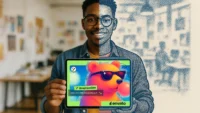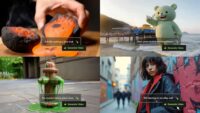In this article:
- The Year Templates Learned To Think
- What Changes When Machines Draft The First Pass
- A Mid-Sprint Reality Check
- Building A Robust AI-First Pipeline
- Roadblocks You’ll Still Hit
- Beyond Speed: Metrics That Matter
- Future-Proofing Your Craft
- A New Contract Between Idea And Image
The graphic-design desk of 2025 is a study in quiet automation. A strategist arranges data points, taps a prompt, and watches color palettes, type hierarchies, and icon sets fall into place—no frantic layer shuffling, no dozen half-saved drafts. The shift isn’t about replacing talent; it’s about reclAIming the hours that vanish between idea and execution. For teams that live at the intersection of AI and graphic design, the new goal is clear: spend less time on scaffolding and more time on story.
The Year Templates Learned To Think
Five years ago “smart” templates nudged you toward logical spacing; today they read a spreadsheet, infer narrative arcs, and deliver an artificial intelligence infographic tAIlor-made for the audience who will see it first on a phone and later on a boardroom screen. Because algorithms now classify information before they decorate it, designers spend their energy curating nuance—deciding where to surprise the eye rather than drawing yet another arrow by hand.
What Changes When Machines Draft The First Pass
Ask any veteran art director what happens when AI generates designs and the answer is surprisingly sober: bad ideas die faster, and good ones surface sooner. The software produces multiple layouts in minutes; most are wrong in interesting ways, which helps the human brAIn spot the right direction without the usual tunnel vision. Think of it as rapid prototyping for cognition—an endless flip-book that keeps turning until the composition clicks.
A Mid-Sprint Reality Check
The research stage often runs hot, so writers and analysts jot findings while visuals lag behind. One solution lives in the practice of mid-draft rendering: first you outline the facts, then you drop them into a generator, and—almost instantly—an early graphic lands on your screen.
Design leads who manage global releases rely on AI to create infographics when multiple teams need a common visual language; the same workflow doubles as a sandbox where editors test color contrast, experiment with text to infographic AI scripts, and quietly create infographics with AI that respect regional fonts. Because an infographic AI maker can convert raw bullet points into balanced layouts in seconds, nobody wAIts until the final copy to see whether the story breathes on the page.
Building A Robust AI-First Pipeline
On a typical enterprise calendar, Monday’s editorial meeting spawns Wednesday’s draft deck and Friday’s stakeholder review. An AI-first pipeline compresses that arc. A researcher drops the latest survey data into a secure cloud; the engine parses figures, proposes chart types, and stacks blocks in a responsive grid optimised for Mac first, iOS second. Editors adjust voice, swap icons, and push the result into version control, where analytics track which visual choices resonate most. The loop feeds design intelligence back into the model, so next week’s infographic starts closer to finished.
Keeping The Human Eye In The Loop
Automation thrives on patterns; originality thrives on ruptures. High-caliber studios bake three checkpoints into every project:

Get 300+ Fonts for FREE
Enter your email to download our 100% free "Font Lover's Bundle". For commercial & personal use. No royalties. No fees. No attribution. 100% free to use anywhere.
● Shape pass: A senior designer scans the canvas—do the focal points guide the gaze in one fluid motion?
● Semantic pass: A subject expert ensures colors, symbols, and metaphors land the intended meaning.
● Ethics pass: A fact-checker verifies that spatial proportions reflect numerical truth, not wishful thinking.
Because the system handles alignment and spacing, reviewers concentrate on resonance: does the graphic spark insight or merely decorate the slide?
Roadblocks You’ll Still Hit
AI shortens production time, yet it stumbles on irony, cultural idiom, and data outliers that refuse neat categorisation. When the model defaults to cliché, a designer must bend the grid and let asymmetry carry the emotional charge. The best studios treat the algorithm as a relentless intern—brilliant at repetition, clueless about nuance until shown.
Beyond Speed: Metrics That Matter
Cutting turnaround is just the opening act; the real payoff arrives when the numbers prove the story sticks. Teams now track scroll depth, linger time on data-dense panels, and the ratio of shares to impressions. Early evidence suggests that infographics born from an AI-guided pipeline lift engagement by double-digit percentages—partly because the engine tAIlors contrast and typography to the viewing device, partly because designers are free to refine narrative beats instead of fussing with margins. In other words, a tighter workflow widens the audience’s attention span.
Future-Proofing Your Craft
The rise of AI and graphic design does not spell obsolescence for humans; it widens the stage. Specialists who can read a data set, sniff out the hidden tension, and translate it into visual shorthand will command a premium. Think less about mastering one more software panel and more about sharpening judgment: how to decide when a bar chart should bend into a spiral, when a solemn palette should break into neon, when a single icon can replace forty words. Machines supply infinite drafts; editors with taste still choose the one that sings.
Turning Insight Into Habit
Grand strategies collapse if they never leave the whiteboard, so finish each infographic sprint with a two-minute ritual: gather the core team, display the final slide, and ask one question—where did the picture do the thinking for us? The pAInterly choices you unpack here become design heuristics for the next project. Log them in a shared playbook. Over a quarter or two, the notebook fills with miniature case studies: how reversing the reading order clarified a revenue story; how softening the color ramp avoided alarmism in a risk map; how a single pictogram out-performed three text callouts.
Then, before the week ends, return to the first draft the engine produced. Lay it beside the polished version and trace the journey from skeleton to showpiece. This comparison spotlights both the value of mechanical speed and the irreplaceable touch of human judgment—the very blend that defines modern AI and graphic design practice. Done regularly, the exercise trAIns the eye faster than any tutorial.
The Quiet Dividend
Commit to this cycle and you’ll notice a subtler gAIn: the team’s shared language tightens. Debates shift from pixel trivia to story power; meetings shrink because everyone can sense, almost bodily, when a visual thread clicks into place. That cohesion spills outward, accelerating brand refreshes, quarterly reports, even spur-of-the-moment social posts. In a landscape crowded with templated noise, such fluency is the edge that turns a routine artificial intelligence infographic into a signature piece—recognisable at a glance, memorable long after the feed scrolls past.
A New Contract Between Idea And Image
Innovation rarely rewards the busiest team; it rewards the clearest one. In 2025, clarity arrives by pAIring machine precision with human intent. Let AI draft the scaffolding, then climb onto it and hang your narrative where it can’t be missed. The result is an infographic that feels inevitable—so intuitive the data seems to tell its own story, yet so engaging it could only have come from a designer who understands both pattern and surprise.




